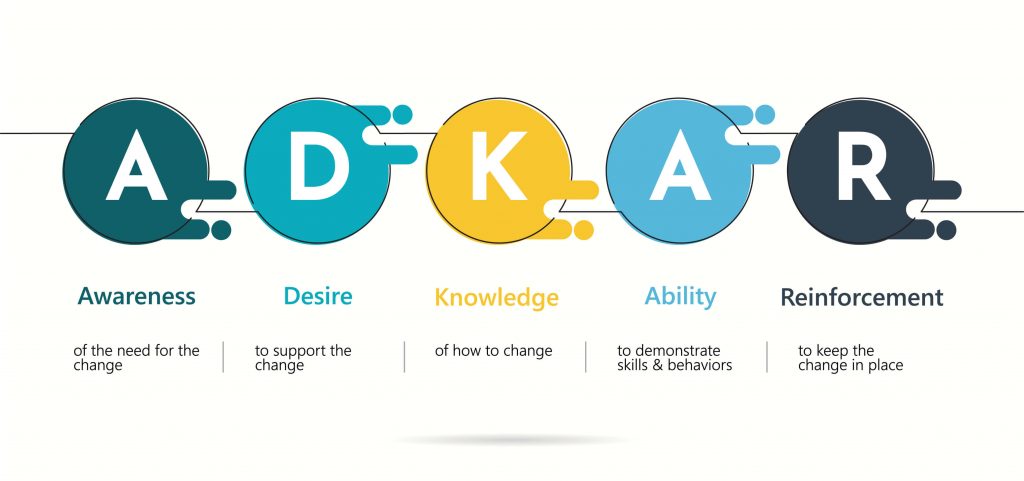

Research from Gartner found that an organization today has implemented an average of five significant organization-wide changes in the past three years — and nearly 75% expect to multiply such change management initiatives in the upcoming three years. However, half of these change initiatives fail, with only 34% finding success.
But, why?
One factor that is paramount for every successful or unsuccessful change implementation is having strong change leadership.
For example, Apple’s iPhone, Microsoft’s Office Suite, and Tesla’s electric vehicles have transformed society and user experience in the era of digital innovation. But they have something else in common, too; they were all developed under the guidance of transformational change leaders.
In this blog, we dive deeper into the concept of change leadership, its models, and how to become a successful change leader.
What Is Change Leadership?
Change leadership is a proactive, people-centric approach to change management, visualizing change initiatives as an opportunity for organizational growth and improvement rather than a finite project. It requires being visionary, agile, and responsive to the changing business requirements, and understanding how to overcome common barriers to change.
Change leaders are not the same as change managers or practitioners. While change managers administer change to achieve short-term goals, change leaders command, influence, and advocate for long-term transformation initiatives. If employees are the driver of change initiatives, change leaders are the ones that empower them to provide inputs. Leaders of change are the ones who engage with the initiative rather than impose change.
For example, General Electric transformed its electrical motors business from 0% to 25% ROI by leveraging market intelligence to enhance employee performance through business innovation. Change leaders at GE Motors employed techniques such as competitor product analysis and customer visits to transform its business.
Change Leadership vs. Change Management
Often change leadership and change management are used interchangeably. However, the question here is whether or not it’s just a matter of semantics. Both these concepts are significantly distinct.
Change management is associated with small-scale changes and is a set of tools and/or measures to keep a change effort under control and to provide solutions to any organizational resistance to a change. The goal is to minimize the change initiative’s disruption, make it cost-effective, and reduce the chances of change failure. On the other hand, change leadership is related to the vision and driving force behind large-scale transformational changes, ensuring the implementation process quicker, more innovative, and efficient.
3 Change Leadership Models
Change leadership is associated with continuous improvement of business processes, which often can be achieved by deploying one of the following prominent change models.
1. The ADKAR Model
ADKAR is a result-oriented change leadership and management model created by Jeffrey Hiatt, the founder of Prosci. This approach works through employee education on the value of the change and how it will impact their day-to-day, while also supporting and reinforcing them throughout the process, allowing them to understand and embrace the value of change.
The five stages of the ADKAR model are as follows:
- Awareness
- Desire
- Knowledge
- Ability
- Reinforcement

This method limits workforce resistance by implementing incremental changes, incorporating employee feedback, and conveying the benefits of the change project.
2. Kotter’s 8-Step Model
Kotter’s 8-step change model works at the organizational level and is best suited for leading large enterprise groups. This change model includes eight steps to manage change, which are as follows:
- Create a sense of urgency
- Build the change team
- Form a strategic vision
- Communicate the vision
- Remove barriers to change
- Focus on short-term wins
- Maintain momentum
- Institute change
A drawback of this model is that it doesn’t include employee feedback, which can be a catalyst for change resistance and slow project implementation timelines.
For example, the cloud data services organization NetApp achieved a 44% increase in revenue, a 55% increase in sales, and a $14 billion growth in market capitalization by leveraging Kotter’s change method to manage and lead a recent change project.
3. The Bacharach Approach
The Bacharach Approach is another leadership approach that organizations can consider. This method views leaders as agents of change. It empowers them with effective corporate and mental tools for driving the change naturally, rather than through forceful, dictatorial leadership.
How Can a Change Leader Make a Difference
Most organizations have a dedicated change management team to combat employee resistance, yet the failure rate of change projects still exceeds 70%.
What do change leaders do differently to set organizations up for success?
- Linchpin Linkages: Change leaders connect top management’s aspirations and strategic intent with market insights, allowing them to convert them into responsive workforce actions.
- Holistic Impact: Change leaders aim to create a holistic impact on their reports, peers, and superiors instead of following the conventional top-down approach. They often influence people to get on board and use several motivational tools to achieve this result. For example, Netflix takes a result-oriented approach instead of micromanagement. It motivates its employees with perks such as unlimited PTO, flexible work schedules, and more as rewards.
- Multiple Approaches: Change leaders aren’t afraid to use various approaches or a combination of leadership models for effectively solving a problem. If their methods cannot adapt to the situation, change leaders delegate others to help lead the current vision to lead the team to the finish line.
8 Tips to Be a Successful Change Leader in 2024
While different change leaders may opt for unique leadership approaches & techniques to drive their company to a unified vision, here are eight tips to become successful change leaders:
1. Have a Clear Vision
A successful change leader is an inspiring visionary. Successful leaders anticipate employee concerns well in advance and address them throughout their vision to support the change. This clarity in vision will help employees overcome fears and keep them engaged throughout the process.
2. Create an Action-Oriented, Strategic Plan
It’s imperative to create a well-detailed strategic plan to kickstart the change initiative and achieve critical milestones. A well-drafted plan helps employees connect with the vision and understand their roles and responsibilities in making the initiative successful. It also highlights the underlying tasks, priorities, structures, behaviors, and resources.
✓ Thank you, the template will be sent to your email
3. Be Proactive in Creating Relationships Across Your Organization
Since change leadership demands a people-centric approach, a change leader must build a strong foundation by creating relationships with internal and external stakeholders. These relationships reduce friction and ensure a smoother change transition.
4. Explore Technological Trends
In the age of digital transformation, harnessing the strength of technology such as digital adoption platforms can make your change leadership more effective. Whatfix’s DAP helps your employees steer through change by providing contextual in-app guidance and on-demand support. It offers intuitive UX features such as pop-ups and beacons, ensuring that small changes don’t go unnoticed.
For example, Sophos uses Whatfix to drive effective change management on its Salesforce instance, attaining the following benefits:
- Reduced support tickets by 12000
- Increased user satisfaction score to 9/10
- Improved employee productivity, saving over 1,070 hours
- Increased Salesforce ROI of 342%
5. Communicate Effectively and Transparently
65% of change leaders feel that clear and frequent communication with employees was the most crucial factor in driving their change efforts. Effective change communication must address the questions such as ‘the need for change’, ‘benefits of change’ and ‘what’s in it for me’. This communication must be bi-directional and encourage employees to voice their concerns.
6. Identify & Confront Barriers and Resistance to Change Head-On
Change imposition is often met with pushback. Change leaders must conduct baseline assessments and ensure employees look at the change as an opportunity instead of a threat. It is equally important to provide consistent support and provide employees with onboarding training to succeed in the change effort.
7. Collaborate with Team Members Across the Organization
Change leaders must lead the change by setting an example. They should create a collaborative culture within the organization so that people can step-up in case of emergencies. They should also collect regular feedback to improve the leadership approach and change techniques for future initiatives.
8. Hold Your Employees Accountable
According to a CEO survey, 18% of the leaders cited “holding people accountable” as their biggest weakness. Since people drive change initiatives, it is essential to hold your employees accountable. Fostering a culture of accountability improves employee performance, empowers team members with a sense of ownership, and drives organization growth.

Embracing change requires more than a change management approach. It needs change leaders who can provide a path, lead, and diligently work to ensure the organization’s success. When change practitioners manage change as it happens, they often attempt to avoid threats. On the contrary, when leaders adopt a change leadership approach merged with technological support, change becomes an opportunity to thrive.
Schedule a demo with our experts to discover how Whatfix can be your partner in driving successful change.

Thank you for subscribing!

